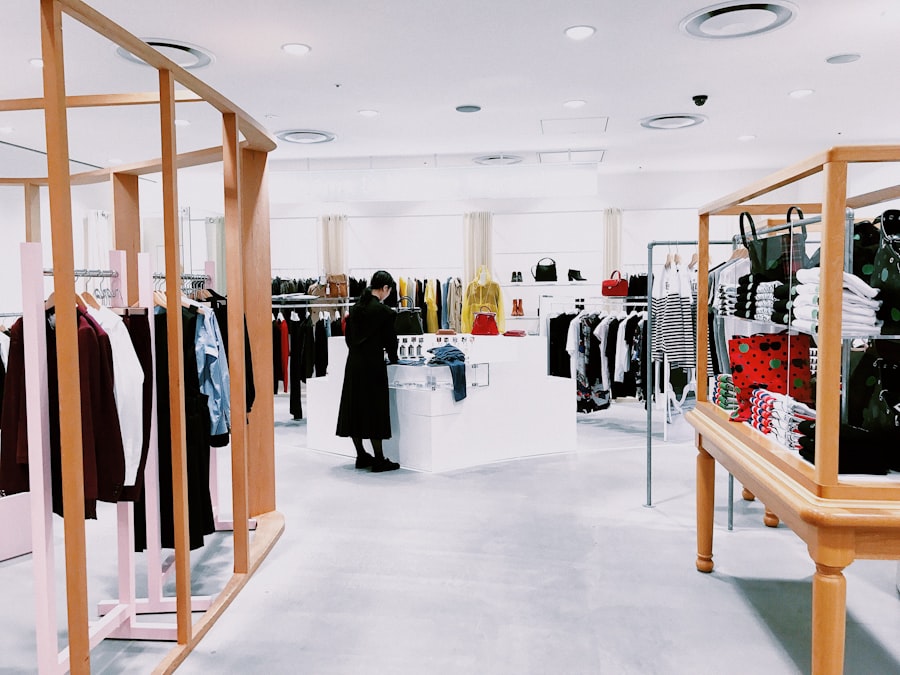Augmented Reality (AR) is a technology that overlays digital information, such as images, videos, or 3D models, onto the real world. It enhances the user’s perception and interaction with their environment by blending virtual elements with the physical world. In the context of retail businesses, AR has become an increasingly popular tool for enhancing customer experiences, improving sales, and gaining a competitive edge.
The use of AR in retail is not a new concept. In fact, it has been around for several years. One of the earliest examples of AR in retail was the “Virtual Dressing Room” developed by Topshop in 2011. This AR application allowed customers to try on virtual clothes using a webcam and see how they would look on their own bodies. Since then, AR has evolved and expanded its applications in the retail industry.
In today’s retail landscape, where online shopping is becoming more prevalent, AR offers a unique opportunity for businesses to bridge the gap between the physical and digital worlds. It allows customers to interact with products in a virtual environment, providing them with a more immersive and engaging shopping experience. This technology has the potential to revolutionize the way retailers connect with their customers and drive sales.
Benefits of Utilizing AR for Retail Businesses
1. Increased customer engagement: AR provides an interactive and immersive experience for customers, which can significantly increase their engagement with a brand or product. By allowing customers to visualize products in their own space or try them on virtually, AR creates a more personalized and engaging shopping experience.
2. Improved customer experience: AR enhances the overall customer experience by providing valuable information and assistance throughout the shopping journey. For example, AR can provide product recommendations, offer styling tips, or provide additional product details through virtual overlays. This not only improves customer satisfaction but also helps customers make more informed purchasing decisions.
3. Enhanced brand image: By incorporating AR into their retail strategy, businesses can position themselves as innovative and forward-thinking brands. AR technology can create a wow factor and generate positive buzz around a brand, attracting new customers and increasing brand loyalty among existing ones.
4. Increased sales and revenue: AR has been proven to drive sales and increase revenue for retail businesses. By providing customers with a more immersive and interactive shopping experience, AR can significantly impact purchase decisions. For example, studies have shown that AR try-on experiences can increase conversion rates by up to 250%.
5. Competitive advantage: In today’s competitive retail landscape, staying ahead of the competition is crucial. By embracing AR technology, retailers can differentiate themselves from their competitors and offer a unique value proposition to their customers. This can help attract new customers, retain existing ones, and ultimately gain a competitive edge in the market.
Understanding the Technology Behind AR
1. How AR works: AR technology works by using sensors, cameras, and computer algorithms to detect and track the user’s physical environment. It then overlays virtual elements onto the real world in real-time, creating a seamless blend of the physical and digital worlds. This is typically done through the use of smartphones or other AR-enabled devices.
2. Types of AR technology: There are different types of AR technology that can be used in retail applications. Marker-based AR relies on markers or images that act as triggers for virtual content to appear. Markerless AR, on the other hand, uses computer vision algorithms to detect and track objects or surfaces in the real world without the need for markers. Location-based AR uses GPS or other location-tracking technologies to overlay virtual content based on the user’s location.
3. AR hardware and software: To experience AR, users typically need a device with a camera and a screen, such as a smartphone or tablet. However, there are also dedicated AR devices available, such as smart glasses or headsets, that provide a more immersive AR experience. In terms of software, there are various AR development platforms and tools available that allow businesses to create and deploy AR applications.
Examples of Successful AR Implementations in Retail
1. IKEA Place app: The IKEA Place app allows users to virtually place furniture and home decor items in their own space using AR technology. This allows customers to see how the products would look and fit in their homes before making a purchase. The app has been widely praised for its accuracy and ease of use, and has helped IKEA increase customer engagement and sales.
2. Sephora Virtual Artist: Sephora’s Virtual Artist app uses AR technology to allow customers to try on different makeup products virtually. Users can see how different shades of lipstick, eyeshadow, or foundation would look on their own face in real-time. This has not only improved the customer experience but also increased sales for Sephora.
3. H&M AR Catalog: H&M’s AR Catalog app allows users to scan select pages of their print catalog to unlock additional content, such as videos or 3D models of the products. This interactive experience has helped H&M engage with their customers in a new and innovative way, while also driving traffic to their online store.
4. Converse Sampler app: Converse’s Sampler app uses AR technology to allow users to virtually try on different styles of shoes. Users can see how the shoes would look on their own feet and walk around with them in a virtual environment. This has not only increased customer engagement but also helped Converse reduce returns by allowing customers to make more informed purchasing decisions.
5. Lowe’s Vision app: Lowe’s Vision app uses AR technology to help customers visualize how different home improvement products would look in their own space. Users can virtually place items such as furniture, appliances, or paint colors in their rooms to see how they would fit and look. This has helped Lowe’s improve the customer experience and increase sales.
How AR Enhances Customer Experience
1. Personalization: AR allows retailers to provide personalized experiences to their customers by tailoring virtual content based on their preferences, location, or past interactions. For example, a clothing retailer could use AR to recommend outfits based on the customer’s style preferences or suggest complementary accessories based on their previous purchases.
2. Interactivity: AR adds an interactive element to the shopping experience, allowing customers to actively engage with products and brands. For example, customers can use AR to virtually try on clothes, customize products, or play interactive games related to a brand or product.
3. Convenience: AR technology can make the shopping experience more convenient for customers by providing them with valuable information and assistance in real-time. For example, customers can use AR to scan products and instantly access detailed product information, customer reviews, or pricing information.
4. Entertainment: AR can also add an element of entertainment to the shopping experience, making it more enjoyable and memorable for customers. For example, retailers can create AR games or experiences that allow customers to interact with virtual characters or objects while shopping.
AR as a Tool for Marketing and Advertising

1. AR in print ads: AR can be used to enhance traditional print advertisements by adding interactive elements or additional content. For example, a fashion brand could use AR to allow customers to virtually try on clothes featured in a print ad or watch a video showcasing the product.
2. AR in social media campaigns: AR can be integrated into social media campaigns to create engaging and shareable experiences for users. For example, a beauty brand could create an AR filter that allows users to try on different makeup looks and share them with their followers.
3. AR in experiential marketing: Experiential marketing is all about creating memorable and immersive experiences for customers. AR can be a powerful tool for experiential marketing, allowing brands to create interactive and engaging experiences that leave a lasting impression on customers.
AR for Product Visualization and Customization
1. Virtual try-ons: AR allows customers to virtually try on products, such as clothes, accessories, or makeup, before making a purchase. This not only helps customers make more informed purchasing decisions but also reduces the need for returns and exchanges.
2. Customizable product options: AR can be used to allow customers to customize products based on their preferences or needs. For example, a furniture retailer could use AR to allow customers to customize the color, fabric, or size of a sofa and see how it would look in their own space.
3. 3D product visualization: AR can be used to create 3D models of products that customers can interact with in a virtual environment. This allows customers to see the product from different angles, explore its features, or even disassemble it to see how it works.
AR for In-Store Navigation and Wayfinding
1. AR store maps: AR can be used to create interactive store maps that help customers navigate through a physical store. Users can simply point their smartphone or AR-enabled device at the store layout and see virtual arrows or markers guiding them to their desired location.
2. AR product locators: In large retail stores, finding a specific product can be a challenge for customers. AR can help solve this problem by providing virtual overlays that highlight the location of the desired product on the user’s screen.
3. AR product information: AR can also be used to provide additional product information or details when customers are browsing in-store. For example, users can scan a product with their smartphone and instantly access customer reviews, pricing information, or related products.
AR for Employee Training and Product Knowledge
1. AR product demos: AR can be used to provide interactive and immersive product demonstrations for employees. This allows them to learn about the product features, benefits, and usage in a more engaging and memorable way.
2. AR training simulations: AR can be used to create realistic training simulations for employees, allowing them to practice their skills in a virtual environment. For example, a sales associate could use AR to simulate customer interactions and practice their sales techniques.
3. AR product information: AR can also be used to provide employees with instant access to product information or details while they are on the sales floor. This can help them answer customer questions more effectively and provide a better customer experience.
Make Extra Money with AR: Monetizing Your AR Implementation
1. AR advertising opportunities: AR provides new opportunities for advertising and sponsorship within AR experiences. For example, brands can place virtual ads or sponsored content within AR applications, allowing them to reach a highly engaged audience.
2. AR product placement: AR can be used to integrate virtual products or branded content into the real world. For example, a furniture retailer could place virtual furniture in a customer’s home using AR, allowing them to see how it would look before making a purchase.
3. AR sponsored content: Brands can sponsor AR experiences or create branded AR content that provides value to users. For example, a travel brand could create an AR app that allows users to virtually explore different destinations and book their next vacation.
4. AR subscription models: Some businesses have successfully monetized their AR implementations by offering subscription-based access to premium AR content or features. This can provide an additional revenue stream and incentivize customers to engage with the brand’s AR experiences.
AR has the potential to revolutionize the retail industry by providing immersive and interactive experiences for customers. By embracing this technology, retailers can enhance customer engagement, improve the overall shopping experience, and gain a competitive advantage in the market. From virtual try-ons and customizable products to in-store navigation and employee training, AR offers a wide range of benefits and applications for retail businesses. It’s time for retailers to explore the potential of AR and leverage this technology to drive sales, increase customer satisfaction, and build a strong brand image.









Add Comment